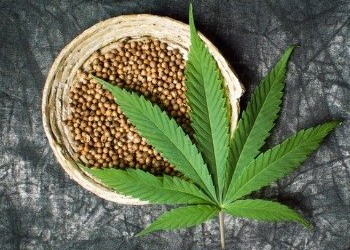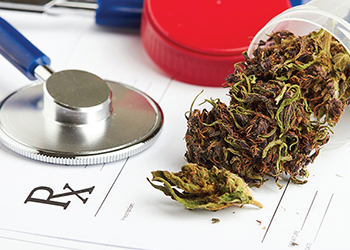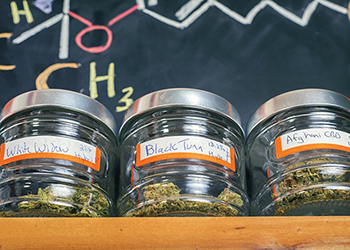The Forbidden Herb: Healing with Hemp and Cannabis
Editor’s Note: This article first appeared in the February 2016 edition of TTAC’s Heroes Against Cancer member newsletter.
Depending on who you talk to, it’s either a dangerous weed rightfully blacklisted by the governmentas a societal vice – or it’s one of the most functionally versatile yet completely misunderstood plants ever to grace God’s green earth. I’m referring to the cannabis plant, the “forbidden herb” that’s rapidly earning itself a fresh reputation as nature’s healing alternative to everything from polluting fossil fuels to dangerous pharmaceuticals.
Perhaps you’ve heard a thing or two about cannabis in recent years. Perhaps you’ve wondered to yourself if this mysterious botanical specimen is really just a mind-altering “drug” that lazy people use to get high. Or if it just might be a panacea with the potential to “heal the nations,” as spoken of in ancient texts like the Holy Bible.
As we explore this taboo subject together, I encourage you to keep an open mind and consider all the facts surrounding one of the world’s most misconstrued plants. Based on what I’ve uncovered in my own studies, I’m now fully convinced that cannabis was placed on Earth by God for our collective good – and I’m very excited to share with you all that I’ve been learning about this amazing gift from nature.
Hemp vs. Marijuana: What’s the Difference?
I spent quite a bit of time researching the history of cannabis as part of my popular docu-series “The Truth About Cancer: A Global Quest.” One of the things I came to realize is that this sacred herb was highly treasured for both its practical and medicinal utility long before it was misrepresented and demonized by corrupt private interests and pandering governments.
Hemp was critical to the establishment of the American colonies and was used to make rope, sails, paper, clothing, and more
Did you know hemp was considered so useful that in 1619 the Virginia Assembly passed legislation requiring all farmers to grow it for the betterment of the commonwealth? In fact, hemp was even allowed to be exchanged as legal tender in Pennsylvania, Virginia, and Maryland!
The type of industrial cannabis commonly grown by our nation’s forefathers is traditionally known as “hemp.” And unlike its polemically charged cousin “marijuana,” hemp can’t be smoked for psychological effects. Many people still don’t realize that there’s a difference between industrial hemp and marijuana, the latter being a slang term with its own sordid history that I’ll get into a little bit later.
But before I do, I think it’s important to point out that our forefathers grew both hemp and marijuana, according to the historical record. America’s first president, George Washington, wrote in his diary about how he separated his hemp plants during cultivation. This is exactly what growers today do to produce a particularly medicinal form of cannabis with higher levels of tetrahydrocannabinol (known as THC) – the primary psychoactive component in marijuana.
An excerpt from George Washington’s diary dated August 1765 reveals that this icon of historical Americana not only grew his own hemp cannabis for industrial use, but also psychoactive cannabis in the form of marijuana:
“Began to separate the Male from the Female hemp… rather too late,” Washington noted in his diary, adding that the male plants were visibly “coarser” and had “larger” stalks than the female plants.
Biologically speaking, both male and female hemp plants come from the same parent species, cannabis sativa. The difference lies in their respective functions. The utilitarian hemp plants are predominantly male, while the mind-affecting “marijuana” plants are all female.
This is an important distinction. It provides not only a historical context for why figures like George Washington separated the two, but also a practical understanding of how the plant is used today. When male cannabis plants come into contact with female cannabis plants, they fertilize the females and cause them to produce seeds. The males also prevent the females from producing the flowers used to produce psychoactive cannabis, which is why growers keep the two separate when producing potent cannabis to be used as medicine.
Was Cannabis Used by Our Founding Fathers?

Cannabis
is an annual, flowering herb. Male plants are hemp, while only the
female plants contain the psychoactive ingredient “marijuana” is known
for
Other famous names linked to cannabis include Benjamin Franklin and John F. Kennedy, both of whom appear to have smoked and/or ingested psychoactive cannabis.
Many ancient cultures throughout other parts of the world – including those in Asia, Africa, and the Middle East – also embraced cannabis as a natural remedy for common health conditions such as inflammation, glaucoma, indigestion, headaches, insomnia, and all sorts of other ailments. And specifically in the United States, cannabis was regarded as science-based medicine up until about 1942, prior to which time it even held a prized spot in the well-respected United States Pharmacopeia (a compendium of drug information).
The Drive to Demonize Cannabis
All of this changed, however, when corrupt textile and pharmaceutical interests began poisoning the minds of the public with politically-charged, anti-cannabis rhetoric during the 1930s.Since many of the Mexican immigrants who were arriving into the U.S. at that time had a penchant for cannabis use, corrupt individuals in government and private industry capitalized on sweeping racist sentiment. Officials spread lies about how cannabis supposedly provoked rape and other forms of violence.
This is how the name “marijuana,” an etymological derivative of “Maria-Juana,” first came to be – the word being a slang term for the “devil’s weed” that was supposedly used by amoral Mexicans and blacks to corrupt the white population… or so the narrative went.
This irrational fervor stoked the early fires of prohibition beginning in the 1910s, which eventually led to incremental changes in laws governing cannabis use all throughout the country. Massachusetts was the first state to officially ban cannabis cultivation and use. As the federal government grew ever larger, a national effort to ban cannabis quickly followed.

Hemp
was used for making paper for thousands of years. The Declaration of
Independence and the U.S. Constitution are printed on hemp paper
“In 1937, the U.S. passed the first Federal law against cannabis, despite the objections of the American Medical Association (AMA),” explains Americans for Safe Access, an advocacy group currently working to undo the damage caused during this critical time in American history.
They go on to say that Dr. William C. Woodward, who was testifying on behalf of the AMA, told Congress that, “The American Medical Association knows of no evidence that marijuana is a dangerous drug” and warned that a prohibition “loses sight of the fact that future investigation may show that there are substantial medical uses for Cannabis.”
But none of this mattered in the end, as Anslinger, Hearst, and the rest of the anti-cannabis crusaders achieved their goal. Cannabis ended up being classified by the government as a Schedule I drug with no recognized medical use, landing it right alongside dangerous street drugs like cocaine and heroin in terms of its potential for abuse and harm.
Truth be told, this classification couldn’t be more inaccurate. And yet, looking at cannabis through any other lens than negative is still a difficult feat for many people who’ve bought into the “Reefer Madness” lie that cannabis is dangerous, useless, and has no place in society. The good news, though, is that the political winds are finally starting to shift and cannabis is once again making its way back into mainstream society.
Healing Properties of Hemp Oil and Seeds

Hemp seeds and hemp oil are legal to purchase in the U.S. and are rich in healthy omega-3 fats
Not to be confused with cannabidiol (CBD) oil derived from cannabis, which I’ll discuss later on, hemp seed oil and the seeds from which they’re derived are widely available at most grocery and health food stores. They’re considered food products because they contain only trace amounts of THC. Many people consume them in smoothies, on salads, or as dietary supplements.
Though it still can’t be legally grown in most places in the U.S. due to antiquated, prohibition-era laws that erroneously lumped it into the same category as psychoactive cannabis, hemp can be legally purchased and consumed throughout the U.S. and much of the rest of the world. Most hemp products sold in the U.S. today are imported from Canada, as Canada’s cultivation laws do differentiate between industrial hemp and psychoactive cannabis.
Hemp seeds and hemp seed oil are among the richest plant-based sources of omega-3 fatty acids – including docosahexaenoic acid (DHA) – which has been shown to protect the heart, brain, and cardiovascular systems. Hemp seed oil is also a powerful antioxidant and anti-inflammatory food product that aids in boosting immune function.
Hemp Oil Soothes the Skin & Improves Blood Flow
People with skin problems may also benefit from consuming hemp oil. One study published in the Journal of Dermatological Treatment found that individuals with atopic dermatitis showed significant changes in their plasma fatty acid profiles and experienced improved clinical symptoms as a result of consuming hemp oil.Hemp seeds are an excellent source of both fat and protein – roughly 25% of each seed is made up of “complete” protein, while another 30% is made up of high-quality fat. Plus there’s all the vitamin E, phosphorus, potassium, sodium, magnesium, calcium, zinc, iron, and sulfur contained in hemp seeds.
Healthy blood flow is a crucial part of human health, and hemp seeds serve an important role in this area as well. Rich in arginine (an amino acid that promotes vasodilation), hemp seeds fuel the body’s production of nitric oxide, which helps relax and expand blood vessels to reduce blood pressure and increase blood flow. In fact, hemp seeds contain all the essential amino acids, which is why they’re considered to be a complete protein. Hypothetically speaking, one could consume nothing but hemp seeds and still maintain pristine health due to the full-spectrum nutrients packed into every kernel.
Shelled hemp seeds are also an excellent source of fiber, both soluble and insoluble, which means smoother sailing for your digestive tract. With colon cancer rates on the rise, adding more hemp seeds to your diet is a great way to help prevent fecal buildup and keep your intestines in tip-top shape.
As I mentioned earlier, industrial hemp is legal in all 50 states, so you’re free to purchase it locally or order it online. I’m partial to the Nutiva brand of both hemp seeds and hemp seed oil because Nutiva products are certified organic; they’re available practically everywhere; and the company is a certified B corporation, meaning it maintains rigorous operations standards that include protecting workers, promoting environmental sustainability, and working towards a zero-waste production model.
Cannabis, the All-in-One Miracle Medicine

Cannabis has countless medicinal uses and has been used to treat conditions ranging from insomnia to cancer
A little background may be relevant here. Cannabinoids are a class of chemical compounds that act on the so-called “cannabinoid receptor proteins” in our body and brain. These receptor proteins can bind to and get activated by the “endocannabinoids.”
Endocannabinoids come from three sources:
- They are produced naturally in the brain and nervous system (interestingly, they are also found in breast milk)
- From phytocannabinoids, including THC, which are found in cannabis and some other plants
- Synthetic cannabinoids that are manufactured artificially.
There are also quite a few variations within these two categories, including sativa-indica hybrid strains that exert both body and brain effects. There are literally hundreds of different cannabis strains offering a wide variety of health benefits, and with suitability for both daytime and nighttime use so patients can focus, sleep, or do whatever it is they need to do at a particular moment in time.

There are hundreds of different cannabis strains offering different effects and healing benefits
“When cannabis is consumed, cannabinoids bind to receptor sites throughout our brain (receptors called CB-1) and body (CB-2),” explains the cannabis information resource Leafly. “Different cannabinoids have different effects depending on which receptors they bind to. For example, THC binds to receptors in the brain whereas CBN (cannabinol) has a strong affinity for CB-2 receptors located throughout the body. By aiming the right cannabinoid at the right receptors, different types of relief are achievable.”
In fact, Leafly has created a “Cannabis Wheel” infographic that offers a visual depiction of the various cannabinoids found in cannabis – and what each one does in the areas of chronic pain, sleep, gastrointestinal health, mood, behavior, and neurological balance.
What is CBD?
CBD is another cannabinoid that, unlike THC, produces no psychoactive effects. This is because CBD binds to cannabinoid receptors throughout the body, rather than only in the brain. This means CBD is able to effectively alleviate symptoms like nausea and vomiting, seizure activity, inflammation, neurodegenerative disorders, anxiety, depression, and psychosis, while also combating tumor and cancer cells.CBD is just one of over 60 active cannabinoid compounds that feed the body’s endocannabinoid system, which is made up of endogenous (originating within the body) cannabinoid receptors designed specifically for the cannabinoids found in cannabis. These receptors are found throughout the human brain, as well as in the central and peripheral nervous systems – and each receptor site is specifically suited for a certain type of cannabinoid.

The trichomes (“hairs”) on the cannabis plant secrete pungent oils called terpenes
Terpenes are what furnish each cannabis strain with its own unique scent and flavor profile, and are similar in nature to those found in common plant-based essential oils that you might use in a diffuser to make your home smell pleasant. There are more than 100 different terpenes that have thus far been identified in cannabis, generating all sorts of pungent flavors and smells ranging from pine and citrus to berry and mint.
Terpenes interact synergistically with cannabinoids to produce what is called an “entourage effect,” enhancing the therapeutic potential of cannabinoids. Terpenes bind to the same receptor sites throughout the body and brain that cannabinoids do, regulating and altering their respective chemical outputs. Terpenes also help modulate how much THC passes through the blood-brain barrier, along with helping to mitigate brain neurotransmitter production, including both dopamine and serotonin.
Cannabis strains rich in the terpene beta-myrcene, for instance, tend to have a musky, earthy aroma and are commonly used to help induce sleep. Strains containing limonene tend to have a distinct citrus aroma, with this particular terpene helping to elevate mood and relieve stress. Other common terpenes found in cannabis include linalool, beta-caryophyllene, alpha-pinene, and humulene.
Leafly has produced another helpful “Terpene Wheel” infographic that offers a full breakdown of six of the most common cannabis terpenes, including their scent characteristics, biological function, other plants in which they’re found – and most importantly, the cannabis strains in which they’re most commonly present.
Don’t Be Misled: Full-Spectrum CBD Oil Comes from Cannabis, Not Hemp
Perhaps you’ve heard the story of young Charlotte Figi, the Colorado girl whose nightmarish epileptic condition was effectively cured with a CBD-rich strain of cannabis known as “Charlotte’s Web.” Ever since her amazing story went public, people across the country have been seeking out CBD oil for their own conditions which – because of inconsistent, patchwork cannabis laws – has created a market for hemp-derived CBD oils that are legal in all 50 states.
Know what you’re buying. CBD oil from cannabis is more potent and healing than CBD oil made from hemp
If you currently live in a state or country where cannabis is still illegal, either medically or recreationally, you may wish to contact your legislators and urge them to introduce or support reform initiatives to end cannabis prohibition.
Building the Biblical Case for Cannabis
As a Christian myself, I recognize that some readers may be wondering whether or not cannabis use is congruent with their religious convictions. I’m excited to tell you that from a Biblical perspective I’m fully convinced that cannabis is safe, beneficial, and good for humanity. Here are a few Biblical passages that help make the case…In Genesis 1:29, God offered up an edict to Adam in the Garden of Eden, declaring, “I have given you every herb bearing seed, which is upon the face of all the earth, and every tree, in the which is the fruit of a tree yielding seed; to you it shall be for meat.” Cannabis is a seed-bearing plant that freely grows like a weed, so it falls into the category of plants given to mankind by God.
In Hebrew and Aramaic translations of the bible (Exodus 30:22-24), God instructs Moses about how to produce the holy anointing oil, one of the ingredients of which is “Q’aneh-Bosm” (also translated as “Kaneh-Bosem”) which many Biblical scholars believe refers to cannabis. Phonetically speaking, this would appear to be accurate.
The Book of Revelation also speaks of a “tree of life” that “yield[s] her fruit every month” and whose leaves “were for the healing of the nations.” There’s been much debate over the identity of this mystical tree, with compelling arguments to suggest that this verse might just be talking about cannabis.
On the flip side, just a few chapters earlier in Revelation 18:23, the book’s writer, John, speaks of all nations being deceived by the “sorceries” of Babylon. The Greek word for sorceries, in this context, is pharmakeia, the root word from which we’ve derived the words pharmacy and pharmaceuticals. Now there’s some food for thought!
Considering the diversity of health benefits to be gained from cannabis – and the fact that it’s a seed-bearing plant blessed by God and the Biblical proof texts that suggest cannabis was one of the ingredients God mandated for use in the holy anointing oil, I’m fully convinced that cannabis is a true gift from God.
I hope you feel the same way, or at the very least now recognize that there’s so much more to this sacred plant than you’ve likely been told.
This article first appeared in the February 2016 edition of TTAC’s Heroes Against Cancer newsletter. Each month in Heroes Against Cancer we share the best ways you can use to get and stay healthy – including delicious recipes and the best in supplements, herbs and spices. Find out more about our member newsletter here.
Article Summary
- Prior to the turn of the 20th Century, cannabis was viewed no more suspiciously than any other plant crop.
- Many ancient embraced cannabis as a natural remedy for common health conditions.
- Hemp seed oil is a powerful antioxidant and anti-inflammatory food product that aids in boosting immune function.
- People with skin problems may benefit from consuming hemp oil.
- Endocannabinoids come from 3 sources:
- They are produced naturally in the brain and nervous system
- From phytocannabinoids, including THC, which are found in cannabis and some other plants
- Synthetic cannabinoids that are manufactured artificially
- CBD is another cannabinoid that, unlike THC, produces no psychoactive effects.
- Cannabis is a seed-bearing plant that freely grows like a weed, so it falls into the category of plants given to mankind by God.

No comments:
Post a Comment